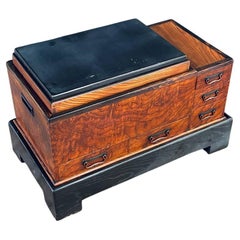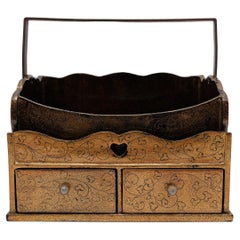Japanese Hokkai Box
Antique 19th Century Lacquer
Lacquer
People Also Browsed
Vintage 1910s Japanese Other Coffee and Cocktail Tables
Wood
Mid-20th Century Japanese Decorative Boxes
Mother-of-Pearl, Wood
Early 20th Century Japanese Taisho Snuff Boxes and Tobacco Boxes
Brass, Sheet Metal
20th Century Japanese Lacquer
Copper
Antique Mid-19th Century Japanese Meiji Lacquer
Brass
Early 20th Century Japanese Taisho Tobacco Accessories
Metal, Copper
Mid-20th Century Japanese Planters, Cachepots and Jardinières
Wood
Early 20th Century Japanese Meiji Lacquer
Copper
Antique 19th Century Edo Lacquer
Brass
Antique Mid-19th Century Japanese Edo Lacquer
Metal, Bronze, Copper
Early 20th Century Japanese Edo Decorative Boxes
Copper
Antique 1880s Serving Pieces
Copper
Antique 1870s Japanese Decorative Boxes
Early 20th Century Vases
Metal
Antique 1890s Japanese Planters and Jardinieres
Wood
Early 20th Century Japonisme Trunks and Luggage
Copper
Recent Sales
Antique Late 19th Century Japanese Meiji Lacquer
Copper
Antique 19th Century Japanese Edo Decorative Boxes
Brass, Copper
Antique 1890s Japanese Meiji Lacquer
Copper
Antique 19th Century Japanese Lacquer
Wood
Antique Early 19th Century Japanese Edo Lacquer
Copper
Antique 1890s Japanese Lacquer
Antique 19th Century Japanese Lacquer
Finding the Right asian-art-furniture for You
From Japanese handmade earthenware pottery, originating circa 14,500 B.C. and adorned with elaborate corded patterns known as jōmon, to natural elm case pieces and storage cabinets built in Qing dynasty–era China to mid-century Thai rice-paper charcoal rubbings, antique and vintage Asian art and furniture make for wonderful additions to all kinds of contemporary interiors.
Eastern elements elevate any home’s decor. Introduce zen sensibility to your living room, dining room and bedroom with the neutral color palettes and the natural materials such as rattan, bamboo and elm that we typically associate with traditional Asian furniture. Decorative handwoven embroideries and textiles originating from India and elsewhere on the continent, which can be draped over a bed or sofa or used as a wall hanging, can be as practical as they are functional, just as you wouldn’t seek out Japanese room-divider screens — often decorated with paintings but constructed to be lightweight and mobile — merely for privacy.
With everything from blanket chests to lighting fixtures to sculptures and carvings, it’s easy to tastefully bring serenity to your living space by looking to the treasures for which the East has long been known.
For British-born furniture designer Andrianna Shamaris, the Japanese concept of beauty in imperfection isn’t limited to her Wabi Sabi collection. She embraces it in her New York City apartment as well. In the living area, for instance, she retained the fireplace’s original black marble while swathing its frame and the rest of the room in bright white.
“We left the fireplace very clean and wabi-sabi, so that it blended into the wall,” says Shamaris, who further appointed the space with a hand-carved antique daybed whose plush pillows are upholstered in antique textiles from the Indonesian island of Sumba.
In the growing antique and vintage Asian art and furniture collection on 1stDibs, find ceramics from China, antiquities from Cambodia and a vast range of tables, seating, dining chairs and other items from Japan, India and other countries.
- What is a Japanese puzzle box?1 Answer1stDibs ExpertFebruary 22, 2021A Japanese puzzle box, called himitsu-bako, are wooden boxes which keep items safe from theft through an intricate mechanical pattern. These boxes require specific steps moving the mechanism to release the obscured lid, opening to reveal the cavity within.
- 1stDibs ExpertApril 5, 2022To clean a Japanese lacquer box, start by moistening a soft lint-free cloth with warm water. Ring it out and then gently rub every surface. Do not use soap as it may damage the lacquer. Dry the box promptly with a second soft, dry lint-free cloth. On 1stDibs, find a variety of Japanese lacquer boxes.
- 1stDibs ExpertApril 5, 2022The inkstone was the most precious and permanent object in a Japanese writing set. It is a mortar used for mixing dry ink with water for the purposes of writing. You'll find a selection of Japanese writing boxes on 1stDibs.
Read More
Chicago’s Pagoda Red Has a Spirited Mix of Asian Antiques and Bold New Art
For 25 years, gallerist Betsy Nathan has leveraged her keen eye and key connections to bring a unique selection of rare finds to the market.
In L.A., Gallerist JF Chen Has Long Championed Eclectic Blue-Chip Design
Now working alongside his daughter Bianca, dealer Joel Chen has presented a most covetable array of antiques, art and contemporary creations for more than 40 years.
12 Calming Spaces Inspired by Japanese Design
From cherry-blossom-adorned walls paired with glamorous lighting to wood-paneled ceilings above checkerboard-patterned chairs, these 12 spaces seamlessly blend Eastern and Western aesthetics.
Rodrigo Rivero Lake’s Mexico City Showroom Is a Museum-Worthy Trove of Spanish Colonial and Asian Antiques
The dealer and curator has spent the past 50 years amassing a collection of exceptional art, furniture and architectural elements that trace the cultural influence of the Spanish empire from Europe to the Americas and beyond.
16 Refined Asian-Inspired Interiors
These spaces exemplify how Eastern elements elevate a home's decor.




